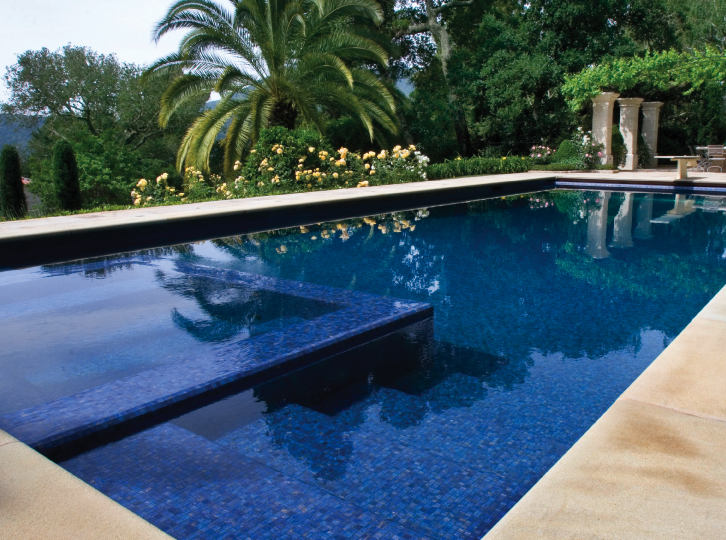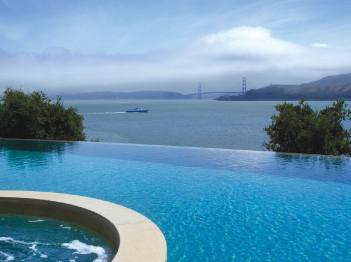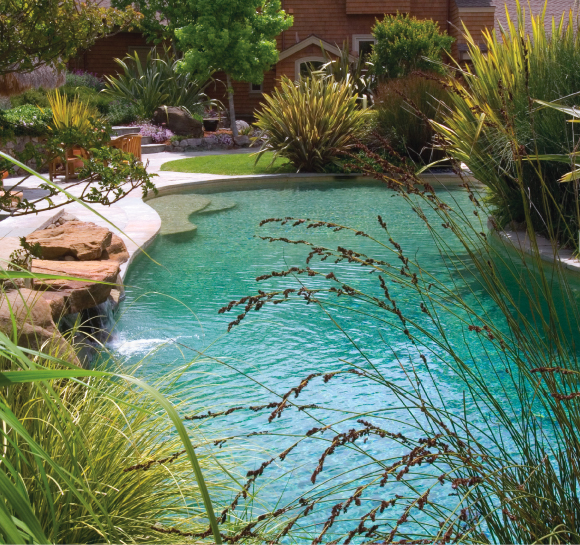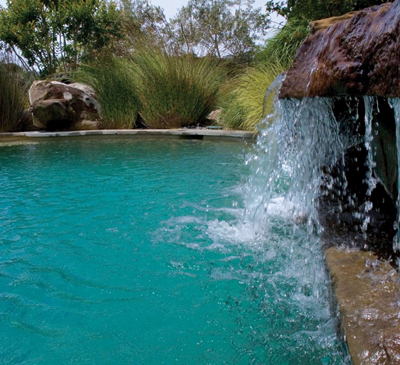More than any other landscape element, swimming pools add drama, style and a literal splash of refreshment to any backyard or garden. These convenient oases are an instant ticket to sensuous floating, serious swimming or spontaneous fun.
With entry-level pools costing about $50,000, any Marin homeowner with at least that much extra cash and even a sliver of land can have one. What’s popular in pools these days? Take a look and jump in—the water’s great!
CLASSIC RIGHT ANGLES
The classic rectangular pool remains the top choice for most buyers, including the clients of Michael B. Yandle, a Ross landscape architect whose pools can be found in many upscale neighborhoods along the Pacific coast.
“Many of my clients have classic East Coast shingle or Mediterranean homes, so the landscape and the outdoor furnishings should reflect the character of the home,” says Yandle. Besides the clean aesthetic of the shape, a rectangular pool also has the practical advantage of easily accommodating a cover that retains water heat and provides safety.
 For his take on a classic pool, Yandle prefers to use natural stone for most copings; a clean-looking white plaster that resists mottling and fading with age; square or rounded edges; and strategic and subtle lighting. The whole point is to keep the look “simple and elegant,” he says. He buries all mechanical maintenance equipment in concrete bunkers (about a $30,000 expense) for soundproofing: “It’s an extreme measure but it makes the livability around the pool all the better.” A rectangular pool also lends itself well to low diving boards, plinths with waterspouts, laminar fountains, water current jets and, on the decking, large planted pots to frame the pool.
For his take on a classic pool, Yandle prefers to use natural stone for most copings; a clean-looking white plaster that resists mottling and fading with age; square or rounded edges; and strategic and subtle lighting. The whole point is to keep the look “simple and elegant,” he says. He buries all mechanical maintenance equipment in concrete bunkers (about a $30,000 expense) for soundproofing: “It’s an extreme measure but it makes the livability around the pool all the better.” A rectangular pool also lends itself well to low diving boards, plinths with waterspouts, laminar fountains, water current jets and, on the decking, large planted pots to frame the pool.
When clients want retro, Yandle references the municipal pools of the early 1900s by incorporating tiled overflow gutters, stainless-steel ladders and a wheel-adjusted white diving board atop a stainless steel platform.
One desirably classic style is the all-tile pool, which lends extra dimension and a clean sparkle to the water. (Think Julia Morgan’s celebrated circular Neptune Pool at Hearst Castle in San Simeon.) All-tile pools are pricey—at least $50,000 to $100,000 more than a plaster pool—but they don’t require replastering. And unlike plaster pools, all-tile pools “come in a range of colors and color combinations, and they won’t mottle or change texture over the years,” says Todd Hendrickson of Petaluma’s Aquascape, a builder of many of Marin’s high-end pools. “That’s the biggest problem people have with plaster pools.”
FROM HERE TO INFINITY
Although popular for years in Europe, infinity-edge pools didn’t start showing up in American backyards until they appeared in the 1971 James Bond spy flick Diamonds Are Forever. At least that’s the theory floated by the trade magazine Pool & Spa News.
What’s unquestionable is the visual impact these pools have, in part because of their undeniable glamour, but also from the improbable trompe l’oeil effect of one or more edge seeming to extend into the horizon.
 To really play up that magical edge, you need the right setting. “They work best with view properties or projects where the pool can match the colors of the sky and sea, blending with the horizon,” Yandle says.
To really play up that magical edge, you need the right setting. “They work best with view properties or projects where the pool can match the colors of the sky and sea, blending with the horizon,” Yandle says.
“Everybody loves the infinity-edge pool,” Hendrickson concurs. “They really do look cool. A rimflow, though, where the water comes up to the very top of the pool, is one of my favorites.”
It’s also a favorite of Jess Janssen, owner of Janssen Pool Construction in Sebastopol. “What’s great about a rimflow is that it works with any shape of pool and in any environment,” he says. “You don’t need to have a slope like you would for a vanishing-edge pool.” And for swimmers there’s the benefit of being able to glide through the water without working against the waves of the kickback from a pool’s backsplash.
NATURE'S WAY
Naturalistic pools have free-form shapes, rocks and boulders, mimicking a wild landscape. With possibilities like fiber-optic lighting, grottoes, waterfalls, slides and diving rocks, this is a Robinson Crusoe–inspired playground for anyone with the heart of a child. Add a swim-up bar and even the least playful adult might join in the fun.
“Everyone wants a pool that fits in with the style of the house. We try to go further and provide a connection to nature,” says landscape architect Warren Simmonds of San Anselmo. “People have stressful lives and being able to connect with nature in your own backyard is very relaxing.”
When he designs a traditional pool, his planting schemes provide that connection, but with properties that have an inherent link to nature—a great view, a grove of native trees, a rock formation—a naturalistic pool is often just the logical choice.
Simmonds uses faux rock made from a cement product that offers longevity and design flexibility without the weight or environmental costs of real rock. When the pool is finished, he says, the faux rock is “indistinguishable from the real thing.”

This style is often enhanced with a beach entry, says Tony Bertotti of Bertotti Landscaping in Petaluma, who uses a sand-colored Pebble Tec finish to achieve the shoreline look. “The ‘beach’ is shallow and can extend six to eight feet into the pool,” he says. “I think people like to sit in a chaise lounge and dangle their feet in the water and kids like to play in the sand.”
Janssen thinks the wave of the future (so to speak) might be the all-natural pool, a good fit for eco-conscious homeowners. For about $25,000 or more, a pool of this design can be filtered naturally using ionization, ultraviolet light and water plants.
Many pools now are treated with salt water rather than chlorine; in fact, it’s the only type of purification system Aquascape installs. “We prefer this method to adding liquid chlorine to pools because liquid chlorine is approximately 12 percent chlorine and 88 percent byproducts,” Hendrickson says. “The byproducts make it more stable to transport, but they also negatively affect the feel of the water on your skin.”
Saltwater pools have softer water and are more “people-friendly,” he adds. “The salt is about the same salinity as our body water or our tears. It’s not like salt water in the ocean. You can barely taste it and because you don’t have freshwater pulling salt water from your eyes, your eyes won’t burn.”
Just re-do it
If you already own a pool but it’s not the pool of your dreams, change it. That’s what Dick McHaney of San Rafael’s Blu Dolphin Pool Service and Repair suggests. You can rebuild in a new shape; remodel with new plumbing, plaster, tile, coping and decking; or just give it a face-lift.
“An outdated pool doesn’t add value to a home,” he says. “In fact, it’s just the opposite: if you’re selling your home, it could take $20,000 to $30,000 off your asking price.”
A $15,000 restoration involving new plaster, tile and coping will add to rather than detract from the value of a home.
Image 1: Classic rectangular pool in Kentfield is focal point for entertainment.
Image 2: Belvedere homes create a dramatic setting for infinity pools that visually expand the view into the Bay.
Image 3: Naturalistic pools can provide a beach-like setting and an adventuresome swimming environment.
Pool design and construction credits: Michael B.Yandle Landscape Architecture, Aquascape, S & S Landscaping; NE Design, Steve Lingnau Construction, Janssen Pool Construction, Gwathney-Siegel & Assoc., Simmonds & Assoc.


